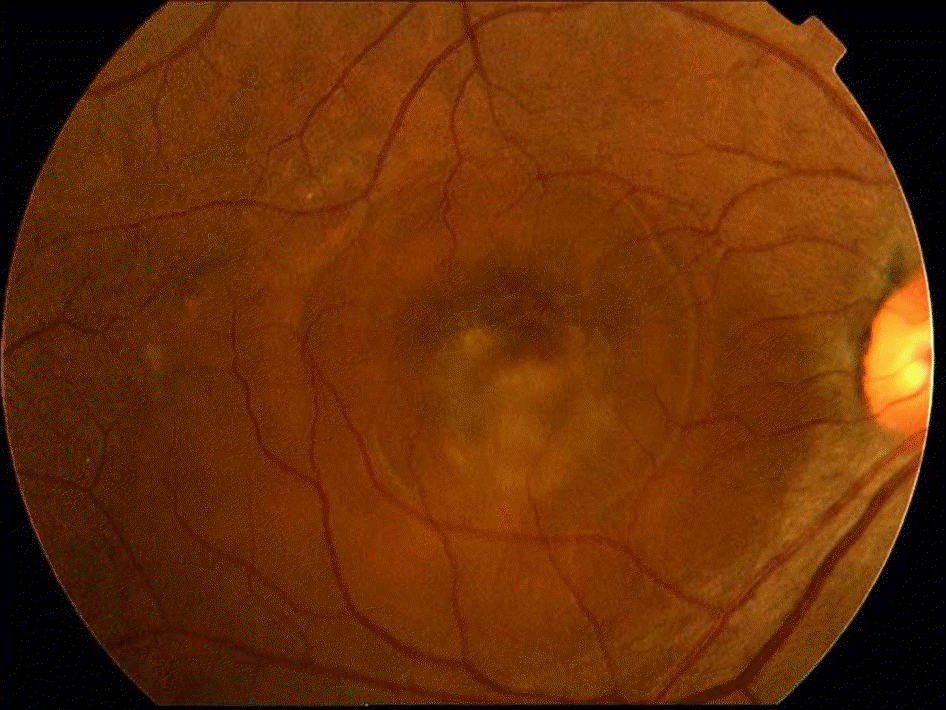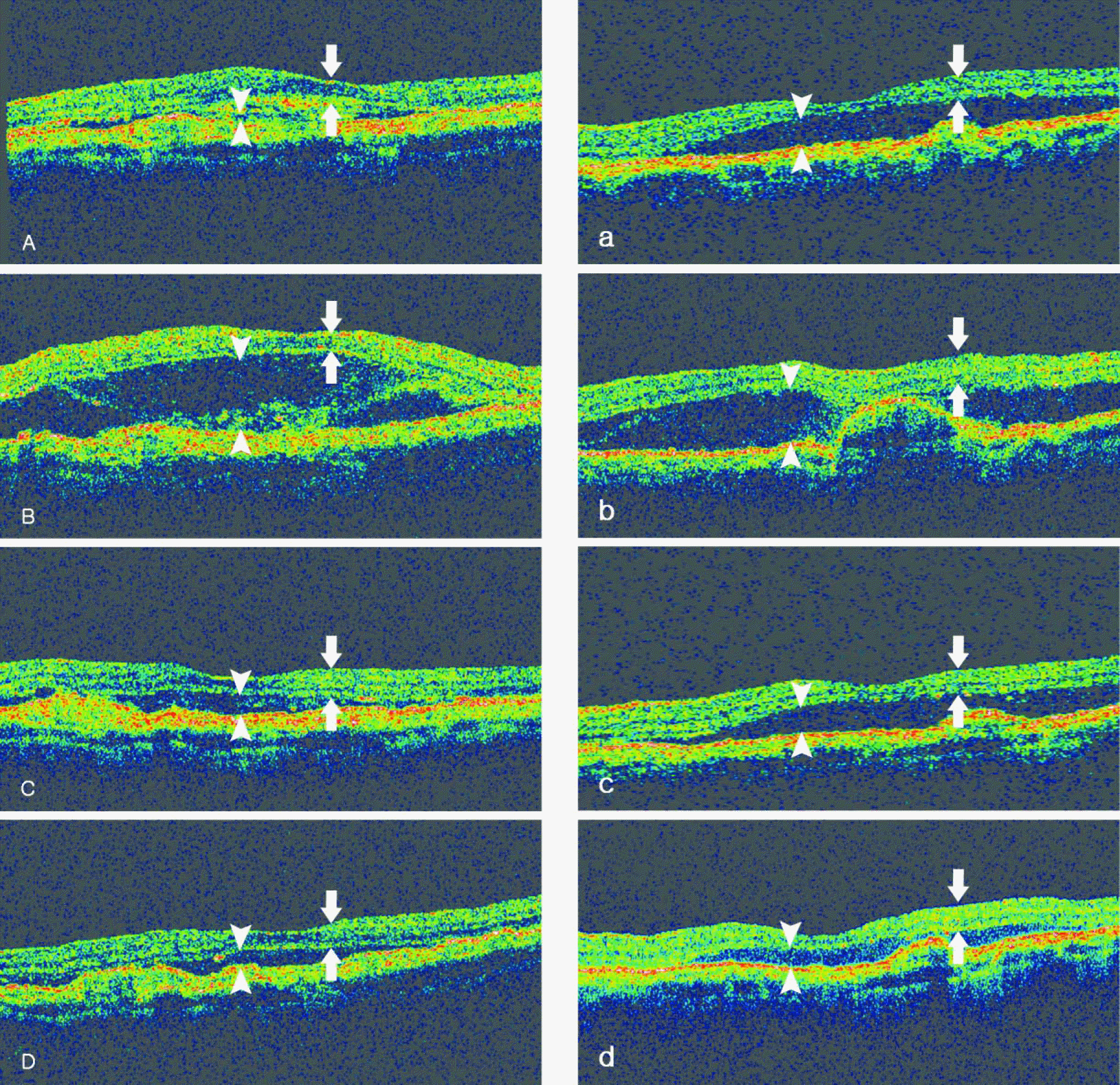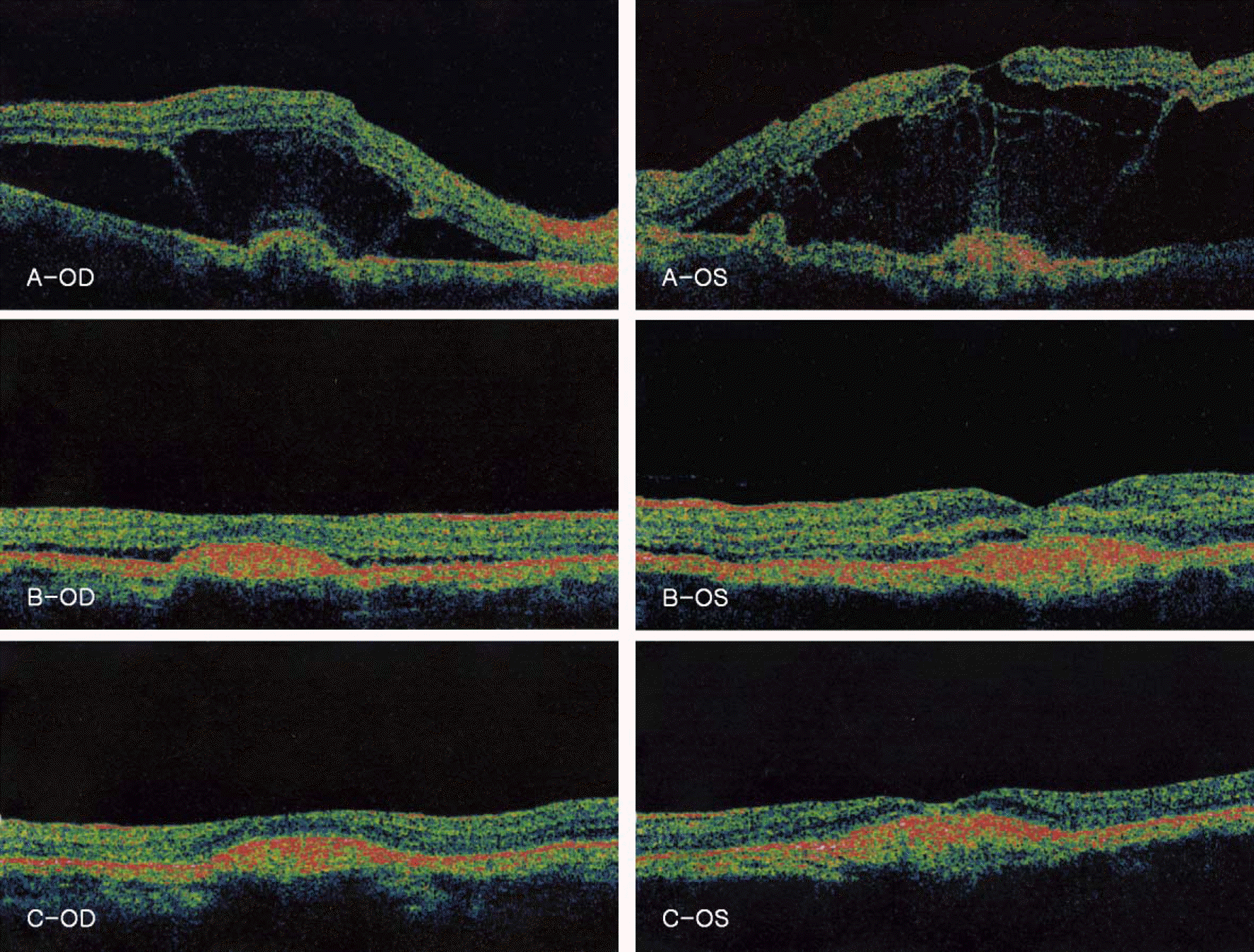Abstract
Purpose
To quantify the development and resolution of serous retinal detachment in patients with choroidal neovascularization (CNV) following photodynamic therapy (PDT).
Methods
Six eyes of five patients who developed serous retinal detachment two days after PDT were included in this study. Retinal thickness was measured by optical coherence tomography (OCT) before PDT, and at two days, seven days, and three weeks after PDT. The number of PDT and the greatest linear dimension (GLD) of the CNV lesion were recorded.
Results
Serous retinal detachment was demonstrated on OCT at two days after PDT. Retinal elevation increased significantly from 313.2 pm before PDT to 640.7 pm two days after PDT (P<0.01); elevation and decreased to 303.2 pm seven days after PDT, and decreased to 223.4 pm three weeks after PDT. The mean number of PDT treatments 2.0 (range: 1∼3), and the mean GLD before PDT was 3122.8±1275.9 pm.
Go to : 
References
1. Bressler NM, Bressler SB, Fine SL. Age-related macular degeneration. Surv Ophthalmol. 1988; 102:374–413.

2. Vingerling JR, Dielemans I, Hofman A, et al. The prevalence of age-related maculopathy in the Rotterdam study. Ophthalmology. 1995; 102:205–10.

3. Treatment of age-related macular degeneration with photodynamic therapy (TAP) study group. Photodynamic therapy of subfoveal choroidal neovascularization in age-related macular degeneration with verteporfin: One-year results of 2 randomized clinical trials-TAP report 1. Arch Ophthalmol. 1999; 117:1329–45.
4. Treatment of age-related macular degeneration with photodynamic therapy (TAP) study group. Photodynamic therapy of subfoveal choroidal neovascularization in age-related macular degeneration with verteporfin: Two-year results of 2 randomized clinical trials-TAP report 2. Arch Ophthalmol. 2001; 119:198–207.
5. Verteporfin in photodynamic therapy (VIP) study group. Photodynamic therapy of subfoveal choroidal neovascularization in pathologic myopia with verteporfin: One-year results of a randomized clinical trials-VIP report 1. Ophthalmology. 2001; 108:841–52.
6. Verteporfin in photodynamic therapy (VIP) study group. Photodynamic therapy of subfoveal choroidal neovascularization in age-related macular degeneration: Two-year results of a randomized clinical trial including lesions with occult with no classic choroidal neovascularization-VIP report 2. Am J Ophthalmol. 2001; 131:541–60.
7. Gelisken F, Inhoffen W, Partsch M, et al. Retinal pigment epithelial tear after photodynamic therapy for choroidal neovascularization. Am J Ophthalmol. 2001; 131:518–20.

8. Pece A, Introini U, Bottoni F, Brancato R. Acute retinal pigment epithelial tear after photodynamic therapy. Retina. 2001; 21:661–5.

9. Goldstein M, Heilweil G, Barak A, Loewenstein A. Retinal pigment epithelial tear following photodynamic therapy for choroidal neovascularization secondary to AMD. Eye. 2005; 19:1315–24.

10. Theodossiadis GP, Panagiotidis D, Georgalas IG, et al. Retinal hemorrhage after photodynamic therapy in patients with subfoveal choroidal neovascularization caused by age-related macular degeneration. Graefes Arch Clin Exp Ophthalmol. 2003; 241:13–8.

11. Gelisken F, Inhoffen W, Karim-Zoda K, et al. Subfoveal hemorrhage after verteporfin photodynamic therapy in treatment of choroidal neovascularization. Graefes Arch Clin Exp Ophthalmol. 2005; 243:198–203.

12. Fingar V, Kik P, Haydon P, et al. Analysis of acute vascular damage after photodynamic therapy using benzoporphyrin derivative (BPD). Br J Cancer. 1999; 79:1702–8.

13. Fogelman AM, Berliner JA, Van Lenten BJ, et al. Lipoprotein receptors and endothelial cells. Semin Thromb Hemost. 1988; 14:206–9.

14. Michels S, Schmidt-Erfurth U. Sequence of early vascular events after photodynamic therapy. Invest Ophthalmol Vis Sci. 2003; 44:2147–54.

15. Costa RA, Farah ME, Cardillo JA, et al. Immediate indocyanine green angiography and optical coherence tomography evaluation after photodynamic therapy for subfoveal choroidal neovascularization. Retina. 2003; 23:159–65.

16. Mennel S, Meyer CH, Eggarter F, et al. Transient serous retinal detachment in classic and occult choroidal neovascularization after photodynamic therapy. Am J Ophthalmol. 2005; 140:758–60.

17. Mennel S, Hausmann N, Meyer CH, et al. Transient visual decrease after photodynamic therapy. Ophthalmologe. 2005; 102:58–63.
18. Rogers AH, Martidis A, Greenberg PB, Puliafito CA. Optical coherence tomography findings following photodynamic therapy of choroidal neovascularization. Am J Ophthalmol. 2002; 134:566–76.

Go to : 
 | Figure 1.Fundus photograph 2 days after photodynamic therapy in a 56-year-old patient with choroidal neovascularization shows serous retinal detachment. |
 | Figure 2.Optical coherence tomography (OCT) before and after photodynamic therapy (PDT) in a 74-year-old patient (A, B, C, D) and a 71-year-old patient (a, b, c, d). (A, a) Before PDT (retinal elevation=304 pm and 360 pm, respectively), OCT images show a hyporeflective area in the subneuroretinal space due to fluid accumulation (arrowheads). Retinal thickness is indicated by arrows. (B, b) 2 days after PDT, OCT images show the large amount of fluid accumulation (increased retinal elevation=757 pm and 549 pm, respectively). (C, c) 7 days after PDT, OCT image shows that the subretinal fluid absorbed, resulting in reduced retinal elevation of 296 pm and 368 pm, respectively. (D, d) 3 weeks after PDT (slightly more decreased retinal elevation=276 pm and 274 pm, respectively). |
 | Figure 3.Optical coherence tomography (OCT) after photodynamic therapy (PDT) in a 56-year-old patient in both eyes. (A) 2 days after PDT, OCT images show the large amount of fluid accumulation in both eyes (increased retinal elevation=907 pm (OD) and 744 pm (OS)). At 3 days after PDT, intravitreal triamcinolone acetate injection was performed in the left eye, but no treatment was done in the right eye. (B) 7 days after PDT, OCT images show that the subretinal fluid absorbed nearly completely in both eyes, resulting in reduced retinal elevation of 205 pm (OD) and 399 pm (OS) (C) 3 weeks after PDT (more decreased retinal elevation=150 pm (OD) and 166 pm (OS)). |
 | Figure 4.Fluorescein angiograph (FAG) and Indocyanine green angiograph (ICG) before and 2 days after photodynamic therapy (PDT) in 66-year-old patient with choroidal neovascularization. (A) FAG before PDT (B) FAG 2 days after PDT shows serous retinal detachment (C) ICG before PDT (D) ICG 2 days after PDT |
Table 1.
Retinal elevation was demonstrated by optical coherence tomography (OCT) in 6 cases of choroidal neovascularization (CNV) before, 2 days, 7 days, and 3 weeks after photodynamic therapy (PDT)
| Cases | Sex | Age (Yr) | CNV type | GLD* (μm) | No. of PDT |
Retinal elevation (pm) (Visual acuity) |
|||
|---|---|---|---|---|---|---|---|---|---|
| Prior to PDT | 2 days after PDT | 7 days after PDT | 3 wks after PDT | ||||||
| 1 | M | 74 | classic | 4738 | 2 | 304 (0.3) | 757 (0.1) | 296 (0.4) | 276 (0.8) |
| 2 | M | 71 | occult | 3100 | 2 | 360 (0.2) | 549 (0.1) | 368 (0.2) | 274 (0.15) |
| 3 | F | 56 | classic | 1650 | 3 | 258 (0.4) | 907 (0.15) | 205 (0.4) | 150 (0.5) |
| 4 | F | 56 | classic | 3600 | 3 | 387 (0.1) | 744 (0.06) | 399 (0.06) | 166 (0.04) |
| 5 | M | 53 | classic | 1609 | 1 | 368 (0.02) | 483 (0.15) | 347 (0.2) | 251 (0.3) |
| 6 | M | 66 | occult | 4040 | 1 | 202 (0.4) | 404 (0.2) | 204 (0.4) | N/A† |
| Mean | - | 66.7 | - | 3122.8 | 2.0 | 313.2 (0.25) | 640.7 (0.1) | 303.2 (0.3) | 223.4 (0.35) |
| SD | - | 14.3 | - | 1275.9 | 0.9 | 72.3 | 192.1 | 83.5 | 60.8 |




 PDF
PDF ePub
ePub Citation
Citation Print
Print


 XML Download
XML Download